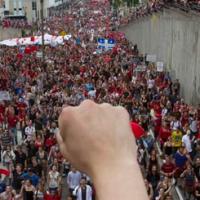
Students take strike action against austerity
Over 35,000 students are currently on strike in Quebec, and 75,000 took to the streets on 2 April to protest the Liberal government’s austerity measures. Though these numbers are impressive, they pale in the face of the “Maple Spring” student mobilisation of 2012. Repression from the government, police and even the university administration has been fierce: 10 students are facing expulsion for their involvement in political actions, and the police have been admitted onto campus to enforce an injunction forcing a return to classes.
In spring 2012, Québec saw the largest mass student movement in Canadian history. At its peak, over 300,000 students were on strike in post-secondary institutions across the province, and on 22 March 2012, over 200,000 students and workers gathered to protest the tuition-fee hike proposed by the Liberal Charest government. Whether or not the strike was victorious is a matter of debate; however, there are two clear results of the movement. The PQ government elected in the fall cancelled the fee hike, and the level of political consciousness of a whole generation of students was significantly raised.
Over the course of 2012-2014, students have sought outlets for their political energy. This led Alternative Socialiste (CWI in Quebec) to found a broad student committee at UQAM, the hub of student activism in Montreal, “Étudiant-e-s socialistes UQAM”. With the mission of uniting socialists and Marxists across the university, we encouraged members to speak up during their student union general assemblies and put forward demands that would defend both students and workers’ interests.
However, the group “Comité Printemps 2015” (spring 2015 committee) has emerged as leading the current student revolt. The group brought together student activists who were already strongly radicalised and made little effort to encourage the general student population to join their movement. All three national student unions, including the militant student union federation ASSÉ, put many years of groundwork into the strike of 2012 in order to build the necessary momentum, whereas the spring 2015 strikes were built over the course of a few months, sometimes passing only by a few votes. Furthermore, ASSÉ has a strong, democratic structure, with elected leaders who are accountable to their members at all times. “Comité Printemps 2015” boasts a horizontal structure with no leadership: there are no specific campaigns or demands other than for a general strike against austerity, and all decisions are made by unelected subcommittees with no accountability.
Despite the lack of democratic leadership in the current movement, and the disdain many students seem to show for anybody who is not mobilised, this movement illustrates nevertheless that an important layer of students are willing to fight back. Many more would do so provided the movement is endowed with clearer goals, and with democratically functioning bodies of action that would allow the whole student population to rally behind the movement, to play an active role in the decision-making process, in the elaboration of the demands and future actions, etc.
The repression from the state and university authorities shows that the ruling class is afraid of the student movement, and of the spectre of the struggle from 3 years ago. But in order for the students to obtain real gains, they must establish strong links with the organised working class, which is in its turn rising up against austerity. Working class anger is running deep in Quebec at the moment, as cuts to wages, pensions and benefits have already provoked mass workers demonstrations in the last months, and strike actions are planned in many sectors in the coming months. A day of mass disruption and strikes across the province, in the form of a 24-hour general strike, followed by escalating actions, would be a good step forward in order to bring workers and students together in the building of mass struggle to finish with this austerity government.


Be the first to comment